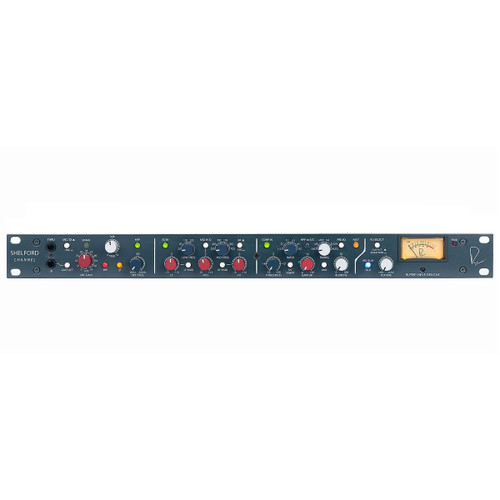The Rupert Neve 5060 Centerpiece Desktop Mixer arrives courtesy of the father of the recording console - A Class-A analog heart for your 21st-century hybrid studio.
Sized for your desktop, the 5060 delivers the tonality and center section features of Rupert Neve's flagship 5088 console at your fingertips, cementing outboard together with serious custom transformers, flexible monitoring, DAW transport controls, and the raw power of a Rupert Neve-designed 24-2 mix-buss. With a modular, hybrid analogue/digital mix system built around the 5060, you can outfit your studio with exactly what you need "" and nothing that you don"?t. Utilizing modern DAW control technologies, the 5060 seamlessly integrates stem outputs from the DAW with the rest of your control room, sums the final mix, and provides 2-track outputs, source selection, and speaker feed outputs from the monitor section.Used in conjunction with 5059 mixers and Portico modules, the 5060 forms the core of a scalable analogue system. In this arrangement, the 5059s provide individual channel control, aux routing, and expandable channel counts, the Portico modules provide preamplification, EQ and dynamics, and the 5060 unites it all. The 5060 brings your dreams of a seamless hybrid workflow to reality.
Define Your Tone
The New Analogue Standard
While digital technologies come and go, the modular, class-A analog designs Rupert created decades ago have been proven to stand the test of time. Instead of merely cloning these "classics", Rupert has spent recent years leading a team of engineers in crafting new designs, built on the same key principals, that take sonic performance, flexibility and ergonomics to new heights. These designs embody the high voltage, class-A, discrete and transformer coupled architectures found in the 5088 console, which represent a culmination of Rupert's vast analogue circuitry knowledge. With the 5060 Centerpiece, the primary aim is to deliver the extraordinary quality of the 5088 in a compact, modular framework. With an abundance of interconnectivity, exceptional fidelity, and the tonal versatility of Silk, the 5060 is the ideal core of the sound-conscious modern studio.
Rupert Neve 5060 Centerpiece Desktop Mixer Features
- New Class-A Topologies - The new +/- 24V class-A topologies in the 5060 are the key to a more detailed, sweeter and spacious mix buss. With zero crossover distortion and unmatched purity, the 5060 delivers the sound of the 5088 to your desktop. To get more dynamic harmonic content out of the mix buss, you can push the levels on the input channels into the mix buss to find the "sweet spot". When pushing the mix buss levels, you may need to lower the master fader to avoid overloading your 2-track input.
- Custom Transformers - Beyond providing ground-loop free interfacing, Rupert's custom transformers in the 5060 are responsible for its larger than life sound. To accentuate the classic tone from the output transformers, you can use the Silk / Texture controls to dial in the desired amount of "color" depending on what each mix needs.
- Stereo Input Channels 1-8 - A professional grade 100mm fader determines the level of stereo input channels 1-8. Channels 1-8 can be either stereo or center-panned mono, and have both mute switches and inserts. The insert send of channels 1-2, and 3-4 has optional talkback assignment for use when feeding channels 1-8 through the 5060 to multichannel queue systems. The insert sends on channels 1-8 may also be used as a pre-fader send to a multi-track recorder.
- Stereo Inputs Channels 9-24 - Eight active stereo inputs with rotary faders for stem and aux inputs.
- Stereo Buss Master - A 100mm stereo fader provides level control for the master stereo buss, outputting to both the stereo buss monitor signal and the stereo master output. For adding compression and EQ to the mix buss, there is also a transformer coupled insert engaged by the Insert switch.
- Texture & Silk Red / Blue - Continuously variable Texture control for Silk Red and Blue modes allows you to fine tune the harmonic ratio and tonality of both stereo outputs when extra "color" is desired. Both Silk modes reduce the negative feedback on the output transformer, adding harmonic content as the texture is increased. Silk red mode accentuates the saturation in the high-mids and highs, while silk blue mode features more saturation in the lows and low mids.
- Talkback - The included talkback mic is activated by depressing the Talkback switch. The Talkback has level control, a direct out, and assignment to insert sends 1-2 & 3-4. When the talkback switch is depressed, the speaker output levels are lowered according to the setting of the Dim control. A talkback remote may also be plugged into the ¼" talkback remote input on the back of the 5060.
- Transport Controls - Standard transport functions in DAWs including play, stop, record, fast-forward, rewind, loop, shuttle / jog and marker drop are controlled through Midi or USB interconnection. USB mode is compatible with Mac OS X 10.3 and up, and Windows 7 & 8.
- Monitor Source Selection - Selects the monitor source from between the stereo buss and three external monitor inputs.
- Monitor Select - Selects which speaker output is active. By holding the Mon 3 button, the Mon 3 outs will "latch" on, allowing both Mon 1 & 2 for use with subwoofers or speakers in the cutting room.
- Headphone Amplifier - A reference grade headphone amplifier with headphone level control. The headphone signal follows the selection of the monitor select.
- Monitor Level - A Precision 21 step attenuator provides highly accurate left/right stereo tracking, perfect repeatability, and determines the level of the monitor output.
- Meters - VU Meters Display the RMS signal level of the selected monitor source, and the peak indicator illuminates red when the peak threshold has been exceeded.
- Dim - Engaged when either the Dim or Talkback switch is depressed, Dim reduces the volume of monitor between -6dB and -30dB.
Rupert Neve 5060 Centerpiece Desktop Mixer Specifications
- Connections
- Mix Inputs 1-24: 2 x DB-25
- Mix Channel Inserts Send/Return1-8: 1 x DB-25
- Mix Send to External Monitor:
- Monitor Outputs (Mon 3 latching): 6 x XLR
- Talkback Output: 1 x TRS
- Talkback Remote: 1 x TS
- Stereo Mix Insert/Return L-R: 4 x TRS
- Stereo Mix Output:2 x XLR
- Midi In / Out: 2 x Midi
- Computer Connection: USB
- Power: 3-Pin IEC
- Dimensions
- 18.5″ wide x 12.5″ deep x 5.75″ high in the back (3.5″ in the front)
- Stereo Outputs (unless otherwise specified, frequency is 1 kHz)
- Channels 1-8 Max input level
- Fader at 0: 25.4 dBu
- Fader at +10: 15.2 dBu
- Channels 9-24 Max input level
- trim at 0: 25.4 dBu
- Max Output level
- Any combination of inputs: 25.4 dBu
- THD+N
- Channels 1-8, fader at unity, THD+N BW <10 Hz "" 80k Hz
- +20 dBu, 20 Hz: 0.023%
- +20 dBu, 2 kHz: 0.0022%
- +20 dBu, 20 kHz: 0.016%
- Channels 9-24, trim at unity, THD+N BW <10 Hz "" 80k Hz>
- +20 dBu, 20 Hz: 0.023%
- +20 dBu, 2 kHz: 0.0032%
- +20 dBu, 20 kHz: 0.017%
- Channels 1-8, fader at unity, THD+N BW <10 Hz "" 80k Hz
- Noise
- BW 22 Hz "" 22 kHz
- Channels 1-24: Better than -90 dBV
- Channels 9-24: Better than -100 dBV
- X-talk: 10 dbu, 10 kH, L/R: -49 dB
- Channel to channel
- CMRR at 1K input to channel 1, 0 dBu fader at unity: -70 dBu
- Frequency Response
- 10 Hz to 120 kHz: +/- 0.25 dB
- 185 kHz: -3 dB
- IMD (Inter-Modulation Distortion)
- +4 dBu, CCIF/DFD: 0.0008%
- Silk (Texture control at maximum)
- Noise
- +20 dBu in, 20 Hz: Better than 5%
- +20 dBu in, 200 Hz: Better than 0.2%
- Frequency Response
- 0 dBu in, 20 kHz "" 2.3 dBu
- Distortion
- +20 dBu in, 20 Hz ""Better than 5%
- +20 dBu in, 200 Hz "" Better than 0.15%
- Frequency Response
- 0 dBu in, 30 Hz: -1 dBu
- Noise
- Peak LED's:
- Trigger Threshold: +22 dBu
- Monitor Outputs
- Max Output level 1 kHz: +25 dBu
- THD+N
- +20 dBu, 20 Hz: 0.023%
- +20 dBu, 2 kHz: 0.0032%
- +20 dBu, 20 kHz: 0.017%
- Noise
- 1-24: Better than -90 dBV
- 9-24: Better than -100 dBV
- Headphone Out
- Max output level: Better than +20 dBu, unloaded
- THD+N
- 2 kHz into 68 ohms, 16 dBu output: Better than 0.02%
- Noise (22 Hz "" 22 kHz): Better than -85 dBV
- Minimum Load: 16 ohms recommended (8 absolute min)
Videos Hide Videos Show Videos
No review yet, Be first to Write a Review
Write a Review



















 Sign Up for exclusive sales and offers!
Sign Up for exclusive sales and offers!